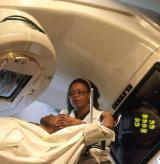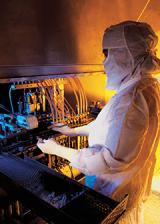Careers in Radiation Protection
Radiation Facts
- Many different professional fields study radiation and how radiation affects the body, the Earth and the environment.
- Several types of specialized medical professions use radiation to perform health tests and treat patients.
- People who work with radiation are protected by laws that limit the amount of radiation exposure they can have each year.
- Specialists in radiation science are called health physicists.
There are many different careers that interact with radiation on the job—you’ve read about many of them here in RadTown! Some people, like doctors and radiologists, use radiation to treat illness. Others monitor the air, soil, and water to protect the environment and people from excess radionuclides. Some people use nuclear gauges to make sure buildings, roads, and bridges are safe for people. Special teams of police officers, firefighters, emergency planners, and emergency responders prepare for emergencies that involve radiation. People who use radiation in day-to-day tasks also work at nuclear power plants, research laboratories, and food processing plants.
About Careers in Radiation Protection
Jobs in radiation protection generally fall into one of the following categories: medical, emergency response, science, research, construction, nuclear power, or waste management. Although every profession listed on this webpage deals with radiation in some way, each profession’s interaction with and use of radiation in the workplace is unique.
Health physics is the discipline of radiation safety and how radiation affects people and the environment. People who study health physics are called health physicists. They are certified by the American Board of Health Physics, and they work in all of the fields listed below.
Medical
Radiologists are doctors who specialize in diagnosing and treating injuries through different kinds of medical imaging. This includes things like mammograms, computed tomography (CT) scans, and x-rays. Radiologists work closely with technicians to make sure the right amount of radiation is used to get a clear picture of a patient, so the patient can be treated or diagnosed. Learn more on RadTown’s Radiation and Medical X-Rays webpage.
Radiation oncologists perform radiation therapy on patients with cancer. They oversee all radiation therapy treatments, along with other people on their team. They sometimes work with radiation oncology nurses, who specialize in caring for patients receiving radiation therapy, or dosimetrists, who help doctors determine the dose of radiation needed. Learn more on RadTown’s Radiation Therapy webpage.
Science and Research
Scientists all over the world, including those that work with particle accelerators and research nuclear reactors, use radiation in their research. Some people study the effects of radiation on the body and others find new ways to use radiation to make products or services. Scientists sometimes use radiation in specialized fields, like chemistry, environmental science, and physics.
Nuclear technicians work in laboratories. They help scientists conduct research and develop new types of nuclear reactors, fuels, medicines, and other technologies. They use equipment such as radiation detectors and particle accelerators to conduct experiments and collect data. They also may use remote controlled equipment to manipulate radioactive materials or materials exposed to radiation.
Researchers sometimes work on teams with chemists, physicists, and engineers to understand how different processes work in plants, animals, and people. They use specialized detectors called “tracers” that track how material travels through a system, like a person’s cardiovascular system. Tracers show where medicines or treatments interact with the body and researchers can then diagnose and treat disease. They also might use radioactive materials to study how certain materials move through plants to test new pest control techniques or materials. These tracers help researchers develop products that can make crops more disease resistant and produce more food. Learn more on RadTown’s Radioactive Material Used in Research webpage.
Emergency Response
Emergency planners support local governments in making plans for responding to all types of emergencies, including radiation emergencies. Emergency planners who specialize in radiation emergencies work closely with scientists, analysts, and communicators to make sure plans for their cities or states are scientifically sound and easily understandable by the public. Learn more on RadTown’s Radiation Emergencies and Preparedness webpage.
Health physicists are specially trained scientists who provide advice and information for first responders, like firefighters and police officers. While they work across all types of radiation fields, they are very important in emergency response planning. They also help city planners by making sure emergency response plans consider public dose limits and any possible lasting doses following a radiation emergency.
Environmental scientists work to determine where radiation may go if radionuclides are released during an emergency. They help create models that show the predicted spread of airborne or waterborne contamination. They also help policy makers decide what safety measures to put in place following an emergency.
Radiation risk communicators work closely with scientists and planners to make sure that the public can understand highly technical concepts. They also make sure that safety instructions are clearly described to those affected by the emergency.
On-scene coordinators are EPA officials who determine the best course of action in an emergency situation. For more contained radiological emergencies, on-scene coordinators make sure that the public is safe, that environmental concerns are addressed, and that a plan of action is established to clean up potential environmental hazards.
Construction
Civil engineers use nuclear gauges to determine the density or thickness of certain materials used when constructing roads, bridges, and buildings. They also use nuclear sources to see if there are cracks in building materials. Learn more on RadTown’s Industrial Radiography webpage.
Nuclear Power
Nuclear power reactor operators control nuclear reactors. They adjust control rods, which affect how much electricity a reactor generates. They monitor the different pieces of a nuclear power plant and sometimes, make adjustments to keep the plant running smoothly. Operators start and stop equipment and collect data. They also respond to possible problems, find out what needs to be fixed, and make changes to ensure the safe operations of a nuclear power plant. Learn more on RadTown’s Nuclear Power Plants webpage.
Power distributors and dispatchers, also known as systems operators, control the flow of electricity as it travels from nuclear power plants to households and businesses. They monitor and operate the different parts of the power transmission process. They detect and respond to emergencies, such as transformer or transmission line failures, which can cause larger power outages. Sometimes, they work with power plant operators to troubleshoot electricity generation issues. Generally, they do not work with nuclear material, but they do work within the nuclear power plants.
Power plant operators make sure that all machinery needed to distribute power to households and businesses are in working order. They also make sure that power is distributed, even as energy demands change over the course of the day. Like power distributors and dispatchers, power plant operators do not work with radioactive material, but do work inside nuclear power plants.
Waste Management
Hazardous materials removal workers clean up and contain materials that are dangerous to people and the environment. Radioactive material is considered hazardous and must be cleaned up in a way that protects worker safety. These workers are trained on the safe handling of radioactive material and must monitor the amount of radiation exposure they receive each year. Learn more on RadTown’s Radioactive Waste webpage.
Radioactive waste management specialists work to create, monitor, and maintain radioactive waste storage facilities across the country. Nearly all spent nuclear fuel is stored on-site at each nuclear power plant. The locations where nuclear weapons were produced are called “legacy sites” and include sites like Los Alamos National Laboratory and the Hanford Site. The waste from these sites is shipped to the Waste Isolation Pilot Plant site in New Mexico. Scientists, engineers, and other specialists work together to make sure that the sites are secure so that the public does not interact with them.
What You Can Do
- Keep studying science, technology, and communications! To pursue a career in radiation science, radiation protection, or radiation risk communication, it is important to learn more about the specific subjects you want to pursue. College coursework is sometimes required, but not always.



